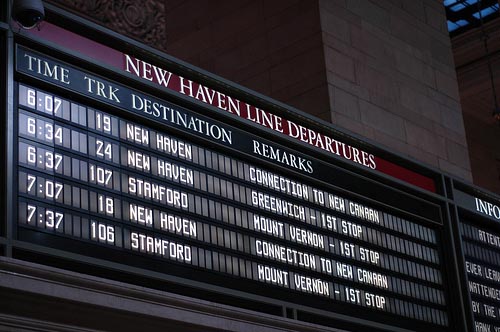Time Travel

At the time of this writing, it is 9:01 PM Eastern Daylight Time in New York City. It’s therefore 6:01 PM in Los Angeles, 7:01 PM in Denver, and 8:01 PM in Chicago. We don’t have to call anyone in those cities to determine that, because about a century ago, the U.S. government promulgated the Standard Time Act. The act, enacted on March 19, 1918, standardized the time (and, temporarily, Daylight Saving Time) throughout the nation, as well as giving a government agency power to officially establish of time zones.
But before the Standard Time Act, time was anything but standard. Cities and towns set their own time (see the bonus fact here for one way), and therefore, it could be 12:32 PM in Chicago, 12:28 PM in nearby Milwaukee, and 12:35 PM in Minneapolis, even though they’re all in the same time zone (now). In general, this wasn’t a big problem, because commerce and communications were either local or slow, and in either case, a few minutes of difference would not matter much, if at all.
And then the trains came.
Railways — which, early on, weren’t linked with one another — were unlike any other mode of transportation until that point. As mass transit was limited to the tracks and stations upon and through which they ran, the trains needed to be at the right place at a precise time in order to pick up passengers and freight. There was no way for the trains to adjust their clocks for the variances of local timekeeping. This was especially true given that town clocks were hardly immune from losing or gaining time, depending on how well the official town time was kept. So each railway, copying what had been done in the United Kingdom, created its own standard time — colloquially, “railway time” — which was internally consistent.
But with many railways, the problem got worse before it got better. Not only did each individual town have its own “local” time as well as the “railway” time which often (if not almost always) varied, but each railway had its own time, too. On October 11, 1883, representatives of the U.S. railways gathered in Chicago to solve this problem, and adopted a consistent timekeeping method across most of their services; at the same time, they instituted the first known time zone system. About thirty-five years later, the U.S. government would codify this unified railway time, creating an official time for the whole nation.
Bonus fact: One great example of how unimportant standard time was before railways comes from France during the late 1800s. The city’s official time was kept via a series of tubes which would push out compressed air which townspeople could hook into. It took a few seconds for the air to pass through the system, more if you were further from the source of the air and fewer if you were closer. So, as one book notes, the official time varied by a few seconds depending on where you were.
From the Archives: Hey, Let’s Crash Two Trains Together: A really bad idea involving trains. Really bad.
